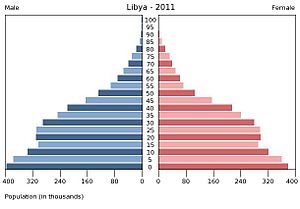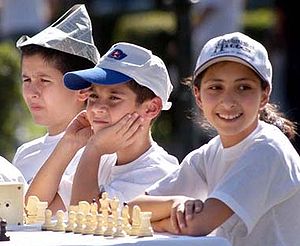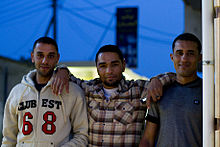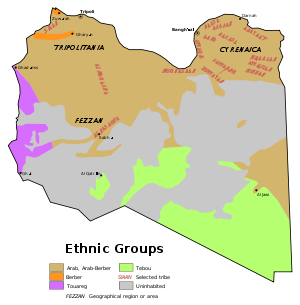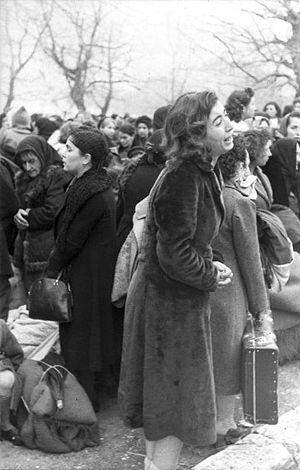- Demographics of Libya
-
Demographics of Libya include population density, ethnicity, education level, health of the populace, economic status, religious affiliations and other aspects of the Libyan population.
No complete population or vital statistics registration exists in Libya. The estimates in this article are from the 2010 Revision of the World Population Prospects which was prepared by the Population Division of the Department of Economic and Social Affairs of the United Nations Secretariat, unless otherwise indicated. [1]
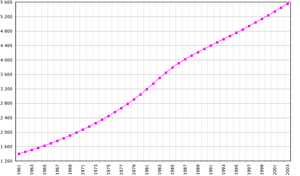 Demographics of Libya, Data of FAO, year 2006; Number of inhabitants in thousands. to see the latest information, please visit this official site: http://www.gait.gov.ly/info/info2.htm
Demographics of Libya, Data of FAO, year 2006; Number of inhabitants in thousands. to see the latest information, please visit this official site: http://www.gait.gov.ly/info/info2.htm
Contents
Population
Libya has a small population residing in a large land area. Population density is about 50 persons per km² (130/sq. mi.) in the two northern regions of Tripolitania and Cyrenaica, but falls to less than one person per km² (2.6/sq. mi.) elsewhere. Ninety percent of the people live in less than 10% of the area, primarily along the coast. About 88% of the population is urban, mostly concentrated in the three largest cities, Tripoli, Misrata and Benghazi. Thirty percent of the population is estimated to be under the age of 15, but this proportion has decreased considerably during the past decades.
thumb|right|300px|king aturk with Libya People in Tripoli 1944.
Total population (x 1000) Population aged 0-14 (%) Population aged 15-64 (%) Population aged 65+ (%) 1950 6 029 41.9 53.4 4.7 1955 6 126 43.0 52.7 4.3 1960 6 349 43.3 52.7 4.0 1965 6 623 43.4 53.0 3.6 1970 6 994 45.2 52.1 2.7 1975 7 066 46.5 51.3 2.2 1980 7 193 47.0 50.7 2.2 1985 7 750 47.3 50.5 2.3 1990 7 834 43.5 53.9 2.6 1995 7 975 38.3 58.8 2.9 2000 8 231 32.4 64.2 3.4 2005 8 970 30.6 65.6 3.8 2010 9 655 30.4 65.3 4.3 Population census
Eight population censuses were carried out in Libya, the first in 1931 and the most recent one in 2006[2] [3]. The population sixfolded between 1931 and 2006.
Year Males (thousands) Females (thousands) Total population (thousands) Average annual growth rate (%) 1931 704 1936 463 386 849 3.8 1954 564 524 1,089 1.4 1964 (31 July) 813 751 1,564 3.7 1973 (31 July) 1,192 1,057 2,249 4.1 1984 (31 July) 1,954 1,689 3,643 4.5 1995 (11 August) 2,237 2,168 4,405 1.7 2006 (15 April) 2,934 2,723 5,658 2.3 Vital statistics
During the past 60 years the demographic situation of Libya changed considerably. Since the 1950s, life expectancy increased steadily and the infant mortality rates decreased. As the fertility rates remained high until the 1980s (the number of births tripled between 1950-55 and 1980-85), population growth was very high for three decades. However, after 1985 a fast decrease in fertility was observed from over 7 children per woman in the beginning of the 1980s to less than 3 in 2005-2010. Because of this decrease in fertility the population growth slowed down and also the proportion of Libyans under the age of 15 decreased from 47% in 1985 to 30% in 2010.
Births and deaths
Period Live births per year Deaths per year Natural change per year CBR* CDR* NC* IMR* TFR* 1950-1955 52 000 24 000 28 000 48.0 22.5 25.5 185 6.87 1955-1960 60 000 25 000 35 000 48.5 19.9 28.6 170 6.97 1960-1965 73 000 27 000 46 000 49.0 18.3 30.7 150 7.18 1965-1970 90 000 30 000 60 000 49.5 16.8 32.7 125 7.48 1970-1975 109 000 33 000 76 000 49.0 14.8 34.2 105 7.59 1975-1980 131 000 35 000 96 000 47.3 12.7 34.6 68 7.38 1980-1985 158 000 38 000 120 000 45.6 10.9 34.7 50 7.18 1985-1990 123 000 22 000 101 000 29.9 5.3 24.6 38.0 5.65 1990-1995 113 000 20 000 93 000 24.7 4.5 20.2 28.3 4.10 1995-2000 115 000 20 000 95 000 23.0 4.0 19.0 20.5 3.25 2000-2005 134 000 22 000 112 000 24.3 4.0 20.3 17.7 3.00 2005-2010 145 000 24 000 121 000 24.0 4.0 20.0 15.0 2.72 * CBR = crude birth rate (per 1000); CDR = crude death rate (per 1000); NC = natural change (per 1000); IMR = infant mortality rate per 1000 births; TFR = total fertility rate (number of children per woman) Life expectancy at birth
1950-1955: 52.9 (males 51.9; females 53.9)
1955-1960: 55.5 (males 54.3; females 56.6)
1960-1965: 58.0 (males 56.7; females 59.3)
1965-1970: 63.4 (males 59.0; females 61.8)
1970-1975: 67.0 (males 61.4; females 70.5)
1975-1980: 70.7 (males 66.0; females 69.3)
1980-1985: 72.4 (males 70.6; females 74.2)
1985-1990: 76.4 (males 74.5; females 78.9)
1990-1995: 76.0 (males 76.9; females 75.7)
1995-2000: 79.6 (males 79.3; females 80.5)
2000-2005: 80.8 (males 80.5; females 80.7)
2005-2010: 80.0 (males 79.7; females 81.9)Ethnic and tribal groups
Ethnic groups
The native population of Libya is primarily Arab or a mixture of Arab-Berber ethnicities, with a small minority of Berber-speaking tribal groups and small black African groups like Tuareg and Tebu tribes can be found in southern Libya, which are nomadic or semi-nomadic. Most of the Libyans claim descent from the Bedouin Arab tribes of the Banu Hilal and the Banu Sulaym, who invaded the Maghrib in the 11th century. There is also some Punic admixture, and a curious traditional element from the Romanized Punics such as the Roman toga can be seen in Tripoli's people and was used by Muammar Gaddafi himself.
In the west of the country, there are some Tuareg nomads, mobile across the Libyan-Algerian border. Tuaregs are also scattered over Algeria, Mali, Niger and Burkina Faso.
In the southeast, there are small populations of the Nilo-Saharan Toubou, although they occupy between a quarter and a third of the country, and who also inhabit Niger and Chad.
Among foreign residents, the largest groups are from other African nations, including citizens of other North African nations (primarily Egyptians) as well as sub-Saharan Africans.
Tribal groups
Libyan society is to a large extent structured along tribal lines, with more than 20 major tribal groups. The major tribal groups of Libya are:[4]
- Tripolitania: Warfalla, Tarhona, Al-Fwatir, Awlad Busayf, Zintan, Al-Rijban.
- Cyrenaica: Al-Awagir, Al-Abaydat, Drasa, Al-Barasa, Al-Fawakhir, Zuwayya, Majabra.
- Sirte: Qadhadhfa, Magarha, Magharba, Al-Riyyah, Al-Haraba, Al-Zuwaid, Al-Guwaid.
- Fezzan: Al-Hutman, Al-Hassawna; Toubou, Tuareg.
- Kufra: Zuwayya; Toubou.
Foreign population
Foreign population is estimated at 3%, mostly migrant workers in the oil industry from Tunisia and Egypt, but also including small numbers Greeks, Maltese, Italians, Pakistanis, Turks, Indians and people from former Yugoslavia. Due to the 2011 Libyan civil war, most of these migrant workers have returned to their homelands or simply left the country for a different one.
Languages
The official language of Libya is Standard Arabic. The prevalent spoken language is Libyan Arabic, spoken by about 6 million Libyans, besides other Arabic dialects (partly spoken by immigrant workers, partly by native populations), viz. Egyptian Arabic, Moroccan Arabic, Sudanese Arabic, Tunisian Arabic, Ta'izzi-Adeni Arabic, South Levantine Arabic and Hassaniyya Arabic, amounting to a total number of first-language Arabic speakers of about 95% of total population.
SIL Ethnologue estimates for indigenous minority languages in Libya[5]:
- Berber languages: ca. 305,000 speakers
- Domari: ca. 33,000 speakers (2006)
- Tedaga: 2,000
Non-Arabic languages spoken by temporary foreign workers include (with more than 10,000 speakers each): Punjabi, Urdu, Mandarin, Cantonese, Korean, Sinhala, Bengal, Tamil, Tagalog, French, Italian, Ukrainian, Serbian, English.
Religions
Almost all Libyans are Sunni Muslim.
Foreigners contribute very little Christian presence, but there are some churches. A small Jewish community historically lived in Libya since antiquity (see history of the Jews in Libya), but the entire Jewish community in Libya eventually fled the country for Italy, Israel, or the United States, particularly after anti-Jewish riots in the wake of the 1967 Six-Day War between Egypt and Israel.References
- ^ World Population Prospects: The 2010 Revision
- ^ B.R. Mitchell. International historical statistics: Africa, Asia & Oceania 1750-2000.
- ^ United nations. Demographic Yearbooks 1948-2008
- ^ Souhail Karam, Jon Hemming, Tribal ties key to Gaddafi rule, Reuters (2011)[1]
- ^ (English) Ethnologue report for Libya, Languages of Libya
See also
Libya topics History Ancient Libya · Roman Libya · Islamic Tripolitania and Cyrenaica · Ottoman Libya · Italian colony · Italian Libya · Allied occupation · Kingdom of Libya · Libya under Gaddafi · Civil War
Geography Cities · Climate · Districts · Ecoregions · Libyan Desert · Subdivisions · Wildlife
Politics Constitution · Elections · Foreign relations of the Libyan Arab Jamahiriya · Foreign relations of the National Transitional Council · General People's Committee · General People's Congress · Heads of State · Heads of Government · Human rights (LGBT rights) · International rankings · Jamahiriya · Military (Gaddafi authorities) · National Transitional Council · National Liberation Army
Economy Culture Demographics · Education · Health · Islam in Libya · Libyan Arabic · Literature · Media · Music · Public holidays · Religion · Sport · Tourism · Women
Demographics of Africa Sovereign
states- Algeria
- Angola
- Benin
- Botswana
- Burkina Faso
- Burundi
- Cameroon
- Cape Verde
- Central African Republic
- Chad
- Comoros
- Democratic Republic of the Congo
- Republic of the Congo
- Côte d'Ivoire (Ivory Coast)
- Djibouti
- Egypt
- Equatorial Guinea
- Eritrea
- Ethiopia
- Gabon
- The Gambia
- Ghana
- Guinea
- Guinea-Bissau
- Kenya
- Lesotho
- Liberia
- Libya
- Madagascar
- Malawi
- Mali
- Mauritania
- Mauritius
- Morocco
- Mozambique
- Namibia
- Niger
- Nigeria
- Rwanda
- São Tomé and Príncipe
- Senegal
- Seychelles
- Sierra Leone
- Somalia
- South Africa
- South Sudan
- Sudan
- Swaziland
- Tanzania
- Togo
- Tunisia
- Uganda
- Zambia
- Zimbabwe
States with limited
recognition- Sahrawi Arab Democratic Republic
- Somaliland
Dependencies and
other territories- Canary Islands / Ceuta / Melilla / Plazas de soberanía (Spain)
- Madeira (Portugal)
- Mayotte / Réunion (France)
- Saint Helena / Ascension Island / Tristan da Cunha (United Kingdom)
- Western Sahara
Categories:- Demographics of Libya
- Libyan society
Wikimedia Foundation. 2010.

